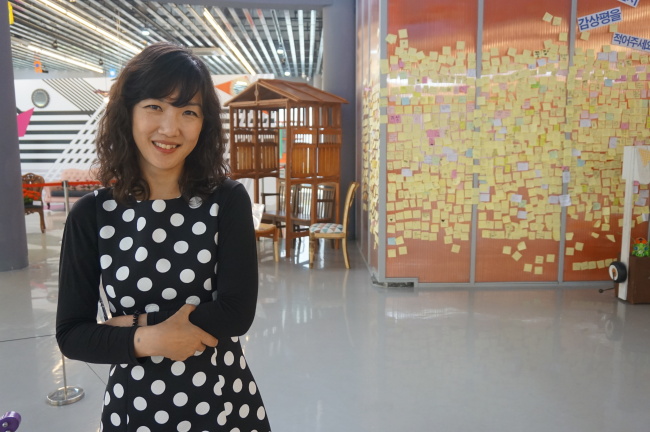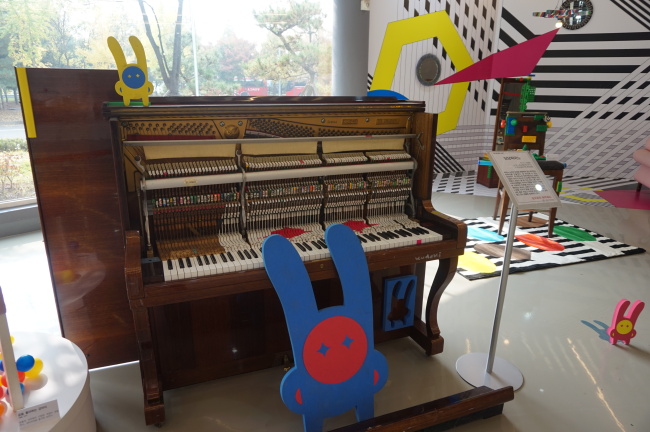A few minutes’ walk from the entrance of Gwangmyeong Cave in Gyeonggi Province stands the Gwangmyeong Upcycle Art Center, which opened in June.
The Korea Herald got a look around the center’s two buildings -- one for exhibitions and one for hands-on classes and seminars -- with Suzy Kang, the executive director of Gwangmyeong City’s Cultural Regeneration Project Team, which oversees the center’s operations.
“This is the first physical space in Korea devoted to the idea of upcycling,” Kang said.
The Korea Herald got a look around the center’s two buildings -- one for exhibitions and one for hands-on classes and seminars -- with Suzy Kang, the executive director of Gwangmyeong City’s Cultural Regeneration Project Team, which oversees the center’s operations.
“This is the first physical space in Korea devoted to the idea of upcycling,” Kang said.

Designed by Belgian architect Laurent Pereira, the center was approved as part of the Culture Ministry’s project to use abandoned industrial centers as cultural spaces. The city of Gwangmyeong’s idea was to remodel the PR building of an old garbage incineration center into a place devoted, appropriately, to art created with objects that have been thrown away.
The exhibition building is airy, with big glass walls, a predominantly red-and-gray color scheme, and a ceiling that opens up to the second floor.
“We thought a lot about the content that would be housed here, and how the building design would reflect that. There was a long study conducted before construction began.”
So what is the content? Kang acknowledged that the concept of upcycled art is not yet commonly known.
“Upcycled art isn’t an actual genre of art,” said Kang. “You can say that its roots were in junk art, which used junk to criticize the inaccessibility of art.”
“But I don’t think of junk art as upcycling. Junk art focuses on creating a particular shape out of particular materials, for example making an animal shape out of old tires, or making a bicycle shape out of plastic bottles. For me, upcycled art is more layered. There’s a message that the artist is trying to convey through a piece, which happens to be made from objects that have been thrown away.”

When asked why upcycled art has only reached a limited audience despite growing interest in the environment and sustainability, Kang quickly named three things: “supply of materials, sales distributions, and price competitiveness.” She said that her dream was to have a warehouse-style center for upcycle-use materials, collecting materials by working with garbage collectors or donations.
Once the pieces are created, Kang said it was important to sell the art in more conventional spaces. “Right now, the upcycled art is being sold in small ‘objet’ markets in Hongdae, but that’s not enough. It needs to break into department stores, places like that.”
As for price, Kang said the government could be doing more. “Upcycled art is 100 percent handmade,” she said. “It’s labor-intensive. If the government could reduce costs in other areas, the price would go down.”
Potential cost-cutting measures she mentioned included support in finding and acquiring materials, marketing, and transporting pieces for sale.
According to Kang, her work is not just about artistic value. The idea behind having classes in addition to the exhibition area is to use upcycled art as a gateway into thinking about broader themes such as sustainable living.
“For sustainability, we need to think about what we can do with art and design. How can we live an eco-friendly life, and keep it sustainable? We can teach people about how they can do their part.”
Currently, the center is holding its second exhibition, called “Re-Born Furniture.” It will run at the Gwangmyeong Upcycle Art Center until next January. Entrance is free, and the center opens from 10 a.m. to 6 p.m. all days except Mondays. For more information, visit gmupcycle.modoo.at.
By Won Ho-jung (hjwon@heraldcorp.com)



![[Exclusive] Korean military set to ban iPhones over 'security' concerns](http://res.heraldm.com/phpwas/restmb_idxmake.php?idx=644&simg=/content/image/2024/04/23/20240423050599_0.jpg&u=20240423183955)




![[Herald Interview] 'Amid aging population, Korea to invite more young professionals from overseas'](http://res.heraldm.com/phpwas/restmb_idxmake.php?idx=644&simg=/content/image/2024/04/24/20240424050844_0.jpg&u=20240424200058)

![[Pressure points] Leggings in public: Fashion statement or social faux pas?](http://res.heraldm.com/phpwas/restmb_idxmake.php?idx=644&simg=/content/image/2024/04/23/20240423050669_0.jpg&u=)








